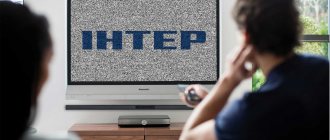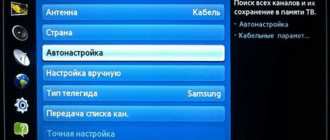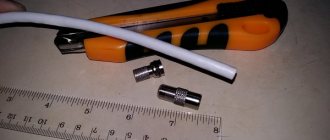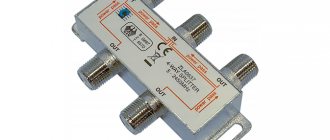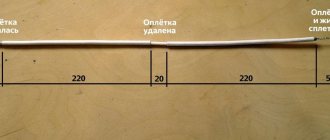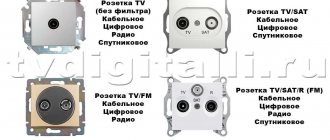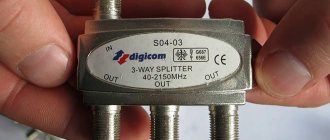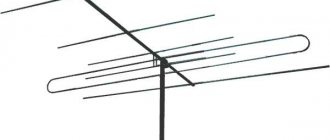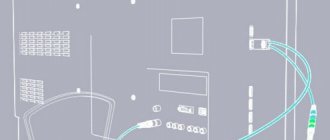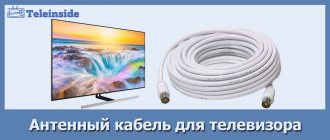We remove the outer insulation of the cable at a distance of about 1 cm. We do this carefully so as not to damage the screen.
Remove the foil and twist the screen wires.
We cut the insulation of the central core, preferably with an insulation stripper, but you can also use a construction knife. In this case, there is no need to make a circular cut, since the wire can easily break at this point.
Remove the insulation from the central core. Make sure that the central core is not oxidized.
We screw on the first part of the antenna plug.
We wind it until the insulation of the central wire is at the shown level.
We screw on the second part of the antenna plug. We make sure that the central wire falls into a special hole. Otherwise the plug will not work.
We check the cable for functionality by connecting it to the TV.
Source
Broken TV plug - repair
The TV screen is snowing; not all channels work. Most often, it is not the TV that is to blame, but the antenna plug that is inserted into the TV socket. If the plug is old, then there is no point in restoring it, but it is better to replace it with a more modern one, which can be found in almost any household goods or building materials store.
Use the knife carefully to avoid injury.
We cut the cable so that the central wire and the screen are at the same level.
We remove the outer insulation of the cable at a distance of about 1 cm. We do this carefully so as not to damage the screen.
Remove the foil and twist the screen wires.
We cut the insulation of the central core, preferably with an insulation stripper, but you can also use a construction knife. In this case, there is no need to make a circular cut, since the wire can easily break at this point.
Remove the insulation from the central core. Make sure the center core is not oxidized.
We screw on the first part of the antenna plug.
We wind it until the insulation of the central wire is at the shown level.
We screw on the second part of the antenna plug. Make sure that the central wire falls into the special hole. Otherwise the plug will not work.
We check the cable for functionality by connecting it to the TV.
Source
TV plug
Previously, in order to connect a plug to a cable, it had to be soldered. Then they began to use antenna connectors, which are mounted by soldering bases. In the first models of this part, the central core of the antenna wire was screwed to the contact with a screw. And finally, they now use international standard type F plugs. Strictly speaking, this connector is simply a bushing that consists of two parts and is screwed onto the antenna wire.
In order for the TV to have a high-quality picture and the signal not to be lost, it is necessary to ensure that there is good contact at the connection point. If this seemingly simple task is not solved correctly, the TV will operate with noise in both image and sound.
To properly connect the antenna wire to the TV, it is not at all necessary to call a specialist. All manipulations can be done with your own hands using simple tools that everyone has.
To solve this problem you will need:
- antenna cable (otherwise known as coaxial cable).
- F type plug.
- knife or stationery cutter.
This is interesting! How to hang a TV on the wall using a bracket
Antenna plug prices
What is a cable?
The antenna cable is a multilayer wire that, due to its shielding properties, can transmit a stable signal. It consists of a central core, copper wire, dense plastic insulation , aluminum foil (the second conductive element), shielding braiding that dampens interference and final external insulation, and protects against weather and mechanical influences.
The market now offers a wide variety of these products, both domestically produced and imported.
- When choosing a wire, you need to pay attention to the number 75 in the marking. It indicates the frequency of the resistance waves of this cable, which is what switching equipment and televisions are designed for. The marking must be present on the wire every meter along its entire length, next to the digital meterage mark.
- The next connector is an F-type plug. Connectors of this type are suitable for both analog and digital television signals. Since such plugs are produced in different diameter sizes, you need to pay attention to this. Make sure the plug matches the antenna wire for the TV. For those cases when the TV is mounted close to the wall, you can use the F plug of the corner design.
Antenna cable prices
How to prepare the cable
Having everything you need, you can start connecting the antenna to the TV. to connect the plug to the antenna cable of a satellite or other antenna: by wrapping the shielding braid and without wrapping it. It would be better and more reliable for contact to wrap the shielding braid, but if this fails, you can not wrap it.
In order to cut the cable, take a knife or cutter and, stepping back 1–1.5 centimeters from the end of the cable, carefully cut the outer insulation in a circle.
The main thing is not to damage the braid and aluminum foil. Remove the cut insulation. Now the exposed part of the braid and foil must be wrapped back onto the wire itself. There is one nuance here. To make the foil stronger , it is covered with polyethylene on the inside. It is impossible to clean the plastic layer without damaging the foil. If you simply push the plug onto the unscrewed part of the foil, the contact will be unimportant or, in general, bad.
In order to avoid this, you need to bend half of the foil back and the conductive part will be on top. Then we remove the central core from the insulation, retreating 0.5–1 centimeter, again trying not to damage the wire itself. Now we wrap the first half of the plug onto the foil. We make sure that the central wire gets into the core of the plug. Afterwards, is “bitten off” with pliers , so that it protrudes from the union nut by 4–6 millimeters. Finally, screw the second part of the plug until it stops. And our antenna plug is ready for use. Can be used for both satellite dishes and analog TV.
If the foil is not wrapped, then the top insulation is simply cut off, the braid is removed and the plug is screwed onto the open section of the cable.
If you happen to have a plug of a previous modification in your hands, which also did not require soldering. It must be connected to the TV cable as follows. Disassemble the plug by disconnecting the plastic half. Place this plastic part on the wire first.
This is interesting! How to determine the size of a TV depending on the diagonal
How to connect a TV to an antenna cable
To connect your TV to cable TV, you need a cable. At its end you need to install an F plug, specially designed for a television antenna. If the user is not very well versed in this issue, then it is better to seek help from specialists. Because if this work is done incorrectly, then both analog and digital signals will not work correctly, which will result in a loss of image quality on the TV.
The choice of cable is of great importance. Even a TV of the latest brand and correctly placed F plugs on the ends of the cable cannot give an excellent picture if a low-quality cable is used. What is the best cable, and how can you recognize it among the many offered on the market?
To do this, you need to have an idea of how high-frequency TV signal current flows through the cable. And the higher this current indicator, the closer it passes to the surface of the conductor. Due to the low height of the television signal in the antenna cable and its high frequency, it is impossible to determine without special devices. You can determine whether there is a signal or not by connecting the antenna to the TV.
This is interesting! What is smart TV, the main functions of smart TVs
The most purchased and widely known on the market are cables with a characteristic impedance of 75 Ohms, which are excellently used for receiving and transmitting television signals. Marking is carried out depending on the increase in quality. It is usually applied to the top layer of the antenna cable along its entire length, every linear meter next to the digital meter mark.
If the consumer has the skills to work with wires and certain knowledge, then he can easily connect the TV to the antenna on his own. The main thing is to follow the instructions and not deviate from the rules.
It is important to remember that the voltage of the television signal in the antenna wire is millionths of a volt. Therefore, such a cable does not pose a danger to human life.
It happens that after the antenna plug is inserted into the TV socket, it becomes impossible to move it closer to the wall because the cable gets in the way . In order to get rid of this problem, you should use a special F-socket, that is, a plug of an angular design.
These two plugs are essentially the same thing, and they are installed in the same way. The only difference between them is in form.
But before their appearance, other plugs were used, the connection technology of which was completely different.
Is it possible to do without a plug?
There are times when you urgently need to connect a cable to your TV, but you don’t have a soldering iron. It turns out that you can do without his help. To do this, you just need to remove the top layer of the shell and remove the braid. Then remove the insulating layer from the central wire of the cable. The wire itself must be folded into a loop, the width of which is slightly larger than the hole in the TV connector socket.
Which antenna plug is preferable?
Definitely the best plug for a television cable is the F plug. Its advantages are the excellent quality of the television signal, as well as ease of installation. Which is undoubtedly more popular among home craftsmen.
In order for the TV to show, you need to connect an antenna to it. For this purpose, the TV has a connector for connection, the so-called antenna socket. The other part of the connection, the plug, is mounted on the antenna cable, which actually connects either to the antenna, even a satellite one, or to the distribution box of the cable television network, if the owner is connected to it.
Malfunctions and their causes
The antenna is a vulnerable part. It breaks often.
Typically, users decide to fix the problems themselves. But before that, it is important to understand what reasons preceded the problems that appeared.
Let's look point by point at what antenna malfunctions exist. Sometimes equipment in a house or apartment stops seeing the television antenna. The following problems may lead to this.
- Broken or broken antenna cable.
- Incorrect frequency settings often lead to the TV no longer seeing the antenna.
- This can also be caused by problems with the tuner.
- The TV may not see the antenna due to problems with the provider itself.
Faulty socket where the antenna plug is inserted. In this case, the cable will be intact, but the TV will not work.
It happens that the antenna stops receiving reception, which is why you may notice that the TV has stopped showing channels. The reasons for this common problem may be as follows.
- Adverse weather conditions. This often happens when there is heavy cloudiness or precipitation. Under such conditions, the TV signal may be scattered. If the antenna is weak and not of high quality, it will not work flawlessly.
- Distance from signal sources . Television signal transmitters are located in large cities. TV signals run the risk of scattering, even if the weather outside is good. If your house or cottage is located at a distance from a television tower, then the home antenna will not pick up signals normally.
- Unauthorized installation of additional equipment . The problem may occur if you live in an apartment building. Here, either one of the residents or certain companies can install equipment that will cause low playback quality on your TV.
Malfunctions in the operation of antennas can also be associated with such events.
- Incorrect TV settings, due to which it cannot “see” the antenna.
- Lack of signal (often occurs due to maintenance work).
- Weak broadcast with interference.
- Possible mechanical damage to the device.
- Mechanical damage to the corresponding connectors in home equipment.
- If the antenna and amplifier do not work, this may indicate that the connection was initially made incorrectly.
- The absence of the required signal often occurs due to the fact that there is a serious overload in the operation of the receiver.
How not to break your TV by connecting an antenna with an amplifier to it
The screens of modern televisions are becoming larger, and the televisions themselves are becoming thinner. And because of this, in some TV models the antenna input is located in such a way that inserting an active antenna plug into it is a real problem. Let's figure out why!
The fact is that the plug for an antenna with an amplifier is often combined with a separator and therefore has certain dimensions; it is much larger than a regular plug. See the picture below if you don’t know what we’re talking about.
TV plugs
Now let's see how these plugs fit into the antenna socket of an LCD TV in which the antenna input is not routed to the back, but to the side. With a regular plug, everything is fine!
A regular antenna plug fits in without any problems.
But with the separator, it is difficult to enter, because the separator is cramped, it rests against the body of the TV and therefore, you have to use force to insert it there. And then the case presses so hard that it tends to break the TV socket.
Separator plug not included
This breaking out may not happen immediately; at first the socket will begin to wobble, and the signal will disappear from time to time. Then the owners themselves begin to pull the plug to return the picture. So they gradually reach the end.
Diagnostics
If the TV connected to the antenna does not work as it should, do not rush into repair work. You will know exactly what to do and how to do it only if you find out what the root cause of the problem is. For this it is important to carry out a diagnosis. This usually takes a little time. Let's consider how you can identify the causes of problems associated with a television antenna.
- Inspect the antenna cable. It must not be damaged or interrupted. To verify this, you can connect a simple home indoor antenna to the device. If the TV works, this will confirm suspicions that the reason is hidden in the cable.
- Carefully inspect the sockets into which the required plugs are inserted. They must be intact and not burnt out.
- Frequencies must be adjusted in accordance with the manufacturer's requirements. Take the instructions and check how these parameters are set for you. If the values do not correspond to those stated, this will indicate that the TV is not working properly due to a frequency setting error.
- You should make sure that your provider works without interruptions, because very often problems associated with broadcasting channels are caused by these events.
- Make sure that the antenna and amplifier have been connected correctly.
- When carrying out diagnostic measures, you should evaluate the performance of the existing equipment as a whole, as well as its compatibility with each other.
It is very easy to diagnose home equipment, but some users prefer to entrust this work to specialists.
Thus, you can significantly save your free time if you already don’t have enough of it to look for problems in technology.
Connecting the cable to the plug
F - male connector
In order to immediately correctly connect the antenna cable to the plug without any modifications, it is enough to follow certain dimensions and sequence of actions, but do not be afraid that you may get an electric shock, since the voltage in the cable is very low. So, to properly strip the TV cable you need:
- at a distance of 12 - 15 mm, make an incision in the outer shell so as not to damage the braid and, tilting it to the sides, break it off and pull it off (you can do this in a way convenient for you);
- wrap the braid;
- when folding the foil, keep in mind that its inner layer does not conduct current, so turn it around the axis again with the outer layer up or remove it altogether;
- cut the dielectric of the central core at a distance of 8 -10 mm from the end and remove it;
- screw the F connector onto the cable;
- screw the plug into the connector.
If the central core protrudes more than 4 mm, it may rest inside the connector and prevent the nut from screwing in completely, so remove the excess.
If the cable diameter is small, you can wrap a little electrical tape and then wrap the braid on it.
Crimp plug
In this case, the central core is clamped with a screw, and the braid is crimped by the plug body:
- a protective casing is put on the cable;
- the outer shell is stripped to 10 mm;
- aluminum foil is removed;
- the insulation of the central core is removed by 3 mm;
- the braid is wound onto the remaining dielectric;
- the central core is inserted into the groove and clamped with a screw;
- the braid is crimped onto the plug body;
- We screw the protective casing onto the body.
Connecting the antenna power supply separator
In this case, when connecting the cable to the power supply, the dimensions change slightly:
Correctly connect the power supply to the antenna
- the outer protective shell is stripped to 15 mm;
- the foil is removed;
- the braid moves towards the protective sheath;
- the dielectric of the central core is removed by 5 mm;
- the cable fastening screws in the separator are loosened;
- The cable is inserted into the resulting openings and clamped with screws.
Be careful when clamping the braid: firstly, it must touch the tinned area on the board; secondly, make sure that the braid does not touch the central core.
How to fix it?
If you decide to independently repair the TV antenna at home, you should start from the detailed step-by-step instructions. You should not neglect any of the listed points if you do not want to make any mistakes or get the wrong result for which you expect.
No signal
Let's take a closer look at what can be done in such a situation.
- If the problem is bad weather conditions, it is recommended to turn off the TV for at least a few minutes . Such factors often affect the quality of signal reception. Often, after turning it back on, it may appear again. If the “no signal” message doesn’t go away after these steps, you don’t need to do anything further.
- If the problem is that the receiver is malfunctioning, it is recommended that you contact support for help. It is also possible to go to the menu of your TV and update the channel lists automatically.
- If the operator carries out equipment maintenance work, an announcement about this should be posted on his website in advance . In this case, absolutely all channels may not be shown. In such a situation, all actions on the part of users are useless - you just need to wait until the maintenance work is completed. After them, the broadcast will continue as usual.
- If the problem is a damaged cable, there is no need to panic . Many users know well how to properly clean and connect gaps. If the defects are more extensive and serious, it is better to buy a new cable and install it instead of the old one, which is no longer looking for a signal.
- It happens that the antenna “does not see anything”, because the problem lies in problems related directly to it. In such a situation, it is advisable not to waste time and immediately seek help from specialists. But before that, you can try to redirect the antenna. To do this, you should enlist the help of another person who will monitor the image on the TV screen while you carry out the relevant manipulations. Loosen the clamps slightly and turn the antenna in one direction or the other.
If the problem was eliminated in this way, at the end you must remember to fasten the part back.
Poor display from common antenna
Let's figure out what to do in such situations.
- A rare occurrence is an overloaded channel. This doesn’t happen very often, but if you do encounter such a problem, you have no choice but to just wait a little.
- As in other cases, the cause could be a TV that you moved, breaking the cable connection to the corresponding socket. Then the repair will be very simple and quick - you just need to resort to reconnection.
- Often, problems with broadcasting channels in this case are caused by damage to the TV itself . For example, if it was hit by lightning. To solve the problem it is necessary to replace the equipment.
- If the amplifier that caught the necessary signals fails, you will need to either repair it or replace it with a new one . If you do not know the design features of this part, it is better to contact specialists.
Other breakdowns
Users often encounter other problems associated with television antennas. Let's take a closer look at some of them.
- Many people experience severe plug wear . This problem may arise due to its long or neglectful use. The solution to this problem can be replacing the damaged part.
- A common cause of malfunctioning television antennas is defects in the mounting areas. In this case, you need to disconnect the antenna, carefully cut out the damaged part, thoroughly clean the ends, and then fix it with the utmost care. To make the joint more reliable and durable, you can resort to additional winding with electrical tape. Make sure that the shortened cable does not cause too much tension on the wire.
- Sometimes poor antenna performance can be due to problems occurring on the roof. So, during the winter seasons it must be cleared of accumulated snow, checking the integrity of all connections and contacts. It is also recommended to inspect the antenna itself for any defects that have appeared.
- Sometimes users complain that the antenna input or plug on their TV gets very hot. In this case, the device requires competent diagnostics. There may be voltage getting to ground. If you cannot determine exactly what is wrong, it is better to turn to specialists.
How to avoid damage to the tuner with the antenna plug
Avoiding all this trouble is quite simple. To do this, you just need to purchase a short television extension cord. 1-1.5 meters is more than enough. An extension cord is a wire with a socket on one end and a plug on the other.
TV extension cord
Then everything is simple, we insert the separator from the antenna into the extension cord socket, and its plug into the TV socket, respectively. And that’s it, problems with a broken socket for the specified reason will not arise.
The only problem may be with purchasing such an extension cord; they are not always available for sale. But this is also easy to solve; you can build such an extension cord yourself.
You will need: a piece of TV cable of the required length, a socket and a plug with F-connectors. This is what they look like.
Plug and socket
Now we install all this equipment on the cable and the extension cord is ready.
Extension cord assembled and ready to connect
Of course, there is a backup option, in case the nest is already torn off or loose, but you don’t really want to do repairs or it’s expensive.
In this case, you can purchase an external tuner for DVB-T2 - This is a terrestrial digital television format. Connect this tuner to your TV, for example via an HDMI cable, and watch TV through it.
I hope this information is useful to you. And the best gratitude to the author is to share the note by clicking on the social network buttons and leave a review. Thank you!
Useful tips and tricks
If you decide to carry out repair work on your television antenna yourself, then you should listen to some useful tips and recommendations.
- When repairing damaged parts (any), it is very important to exercise maximum care and caution. It is necessary to follow this rule so that you do not cause even more damage to already damaged parts.
- If you suspect that the missing signal is due to malfunctions in the work of your provider, it is better not to get lost in guesswork and immediately call their hotline and ask all your questions. If it turns out that this is exactly the problem and your assumptions were justified, then you don’t need to do anything with the equipment. We just need to wait a little.
- Be more careful when setting your TV settings. Often the problem with receiving the necessary signal arises precisely because of this. It is recommended that you set up your home appliances with the instruction manual that comes with all TVs.
- If while watching TV you notice that there are ripples on the screen , breakage and unpleasant noises began to be heard, this will indicate that the problem is most likely hidden in a broken receiver or controller. It is recommended to trust professionals to fix hardware failures.
- If the TV antenna signal reception problem is due to seriously damaged or broken parts , it is best to replace them with new ones. In order not to make a mistake when purchasing fresh spare parts, it is recommended to go to a specialized store and seek help from a sales consultant.
For information on how to fix problems with the antenna, see below.
Causes of failure and ways to eliminate them
There are five main sources leading to malfunction:
- the central conductor has moved away from the socket;
- the plug does not work;
- frequent changes of cables from different signal sources;
- mechanically loose connector;
- Incorrect TV settings.
In the first case, the engineer solders the wire to the protruding contact. Afterwards, you need to bend it so that it fits into the small hole located on the tuner board. He carefully desolders the remaining part of the central contact, trying not to touch other parts. Manufacturers do not recommend doing this yourself: without the experience and necessary knowledge, you can completely break your TV.
Correcting the second breakdown is only possible by replacing the plug. The owner can do this himself, relying on the operating and repair instructions.
Replacing the entire socket is fraught with a situation that arises due to frequent changes of cables. In this case, all the blame falls entirely on the owner, who neglected the rules for operating the equipment. You should entrust the work to a master.
Damage can occur under three circumstances:
- when transporting the device, they forgot to pull out the plug;
- pets often play with wires, resulting in loosening;
- children played with cables.
A specialist will repair the socket or replace it. In such a situation, the owner will be required to do the following: if possible, keep children or animals away from the device. Thus, you will not only protect it from damage, but also protect pets and children from injury or electric shock.
And lastly: before you start repairing, be sure to check if everything is in order with the TV settings. There are times when they “fly off” due to failures in the power supply system. This can happen on modern TV models and older models. You can return them to the desired parameters using the included instructions.
How to conclude a purchase and sale agreement?
The purchase and sale agreement is concluded in simple written form. But at the request of his parties...
Miscellaneous articles
- "Brick Business"
- Where to start ordering a window? Measurement, installation
- Font Barcelona, choice of colors, textures and shapes.
- Automatic traffic jams, design, purpose
- Entrance to the apartment, power supply, distribution boards
- Input to a private house, input device diagrams
- Input and distribution devices
- Construction of the foundation, materials, technology
- VAT refund when purchasing land
- Choice of material for the house, construction technology
Popular
- Home network calculation, power determination
- Methods of connecting wires, technical requirements
- Hamilton switches, choice of colors, textures and shapes.
- Electrical installation products, purpose
- Installation of a block from a socket with a switch
- What to do if the TV plug is broken
- Sockets, purpose, characteristics, device
DIY repair
Before you begin troubleshooting, make sure that the problem is in this part of the device. It happens that problems with channels arise due to the antenna itself (especially for those who have a cable rather than digital connection). Adverse weather conditions (rain, strong winds and snowfall), installation of new equipment (it is possible that neighbors have connected a new TV, which led to a decrease in signal quality or its complete loss) - all this can affect the operation of the unit. But if you are sure that your TV antenna socket needs repair, then use some tips.
- Check cables. They must be intact (without damage or creases).
- Examine the nest. It is possible that there are signs of melting inside (burning smell). If this is confirmed, then immediately disconnect the TV from the network and seek professional help.
- Check your settings. If they are incorrect, set the correct values.
When you are convinced that everything is normal on these points, you can try to correct the situation (replace the element that is broken), strictly following the established sequence of actions:
- carefully, without using physical force, remove the cover of the device and position the board conveniently for the soldering process;
- if the device has capacitors that prevent this from being done, carefully bend them back;
- remember (it’s better to record schematically) how the cover is installed so that there are no problems during further assembly of the device;
- then slowly begin to solder the wire to the central contact core, but do not forget to bend it towards the protruding connection in order to pass it into the existing hole located on the device board;
- at the end, the central contact is soldered, part of the conductor is removed and a new, working connector is inserted (don’t forget to insert the wire into a special opening) and the tuner is soldered.
Follow all safety rules. Try to choose the most correct angle when heating the conductor to avoid burns. If you are not confident in your abilities, then contact a specialist (this will reduce the risk of injury and rendering the equipment unusable).
TV plug
Previously, in order to connect a plug to a cable, it had to be soldered. Then they began to use antenna connectors, which are mounted by soldering bases. In the first models of this part, the central core of the antenna wire was screwed to the contact with a screw. And finally, they now use international standard type F plugs. Strictly speaking, this connector is simply a bushing that consists of two parts and is screwed onto the antenna wire.
In order for the TV to have a high-quality picture and the signal not to be lost, it is necessary to ensure that there is good contact at the connection point. If this seemingly simple task is not solved correctly, the TV will operate with noise in both image and sound.
To properly connect the antenna wire to the TV, it is not at all necessary to call a specialist. All manipulations can be done with your own hands using simple tools that everyone has.
To solve this problem you will need:
- antenna cable (otherwise known as coaxial cable).
- F type plug.
- knife or stationery cutter.
This is interesting! How to hang a TV on the wall using a bracket
Antenna plug prices
What is a cable?
The antenna cable is a multilayer wire that, due to its shielding properties, can transmit a stable signal. It consists of a central core, copper wire, dense plastic insulation , aluminum foil (the second conductive element), shielding braiding that dampens interference and final external insulation, and protects against weather and mechanical influences.
The market now offers a wide variety of these products, both domestically produced and imported.
- When choosing a wire, you need to pay attention to the number 75 in the marking. It indicates the frequency of the resistance waves of this cable, which is what switching equipment and televisions are designed for. The marking must be present on the wire every meter along its entire length, next to the digital meterage mark.
- The next connector is an F-type plug. Connectors of this type are suitable for both analog and digital television signals. Since such plugs are produced in different diameter sizes, you need to pay attention to this. Make sure the plug matches the antenna wire for the TV. For those cases when the TV is mounted close to the wall, you can use the F plug of the corner design.
Antenna cable prices
How to prepare the cable
Having everything you need, you can start connecting the antenna to the TV. to connect the plug to the antenna cable of a satellite or other antenna: by wrapping the shielding braid and without wrapping it. It would be better and more reliable for contact to wrap the shielding braid, but if this fails, you can not wrap it.
In order to cut the cable, take a knife or cutter and, stepping back 1–1.5 centimeters from the end of the cable, carefully cut the outer insulation in a circle.
The main thing is not to damage the braid and aluminum foil. Remove the cut insulation. Now the exposed part of the braid and foil must be wrapped back onto the wire itself. There is one nuance here. To make the foil stronger , it is covered with polyethylene on the inside. It is impossible to clean the plastic layer without damaging the foil. If you simply push the plug onto the unscrewed part of the foil, the contact will be unimportant or, in general, bad.
In order to avoid this, you need to bend half of the foil back and the conductive part will be on top. Then we remove the central core from the insulation, retreating 0.5–1 centimeter, again trying not to damage the wire itself. Now we wrap the first half of the plug onto the foil. We make sure that the central wire gets into the core of the plug. Afterwards, is “bitten off” with pliers , so that it protrudes from the union nut by 4–6 millimeters. Finally, screw the second part of the plug until it stops. And our antenna plug is ready for use. Can be used for both satellite dishes and analog TV.
If the foil is not wrapped, then the top insulation is simply cut off, the braid is removed and the plug is screwed onto the open section of the cable.
If you happen to have a plug of a previous modification in your hands, which also did not require soldering. It must be connected to the TV cable as follows. Disassemble the plug by disconnecting the plastic half. Place this plastic part on the wire first.
This is interesting! How to determine the size of a TV depending on the diagonal
How to connect a TV to an antenna cable
To connect your TV to cable TV, you need a cable. At its end you need to install an F plug, specially designed for a television antenna. If the user is not very well versed in this issue, then it is better to seek help from specialists. Because if this work is done incorrectly, then both analog and digital signals will not work correctly, which will result in a loss of image quality on the TV.
The choice of cable is of great importance. Even a TV of the latest brand and correctly placed F plugs on the ends of the cable cannot give an excellent picture if a low-quality cable is used. What is the best cable, and how can you recognize it among the many offered on the market?
To do this, you need to have an idea of how high-frequency TV signal current flows through the cable. And the higher this current indicator, the closer it passes to the surface of the conductor. Due to the low height of the television signal in the antenna cable and its high frequency, it is impossible to determine without special devices. You can determine whether there is a signal or not by connecting the antenna to the TV.
This is interesting! What is smart TV, the main functions of smart TVs
The most purchased and widely known on the market are cables with a characteristic impedance of 75 Ohms, which are excellently used for receiving and transmitting television signals. Marking is carried out depending on the increase in quality. It is usually applied to the top layer of the antenna cable along its entire length, every linear meter next to the digital meter mark.
If the consumer has the skills to work with wires and certain knowledge, then he can easily connect the TV to the antenna on his own. The main thing is to follow the instructions and not deviate from the rules.
It is important to remember that the voltage of the television signal in the antenna wire is millionths of a volt. Therefore, such a cable does not pose a danger to human life.
It happens that after the antenna plug is inserted into the TV socket, it becomes impossible to move it closer to the wall because the cable gets in the way . In order to get rid of this problem, you should use a special F-socket, that is, a plug of an angular design.
These two plugs are essentially the same thing, and they are installed in the same way. The only difference between them is in form.
But before their appearance, other plugs were used, the connection technology of which was completely different.
Is it possible to do without a plug?
There are times when you urgently need to connect a cable to your TV, but you don’t have a soldering iron. It turns out that you can do without his help. To do this, you just need to remove the top layer of the shell and remove the braid. Then remove the insulating layer from the central wire of the cable. The wire itself must be folded into a loop, the width of which is slightly larger than the hole in the TV connector socket.
Which antenna plug is preferable?
Definitely the best plug for a television cable is the F plug. Its advantages are the excellent quality of the television signal, as well as ease of installation. Which is undoubtedly more popular among home craftsmen.
When connecting the plug to the antenna or connecting the cable yourself, you must follow some rules. This article is about how to correctly connect an antenna cable to a plug without errors.
F-connector "male"
Recommendations for use
To avoid the problems described above, try to follow these recommendations.
- Keep the device away from small children or pets. They may inadvertently damage the device.
- When moving the TV, check that all wires are disconnected.
- Carry out TV diagnostics every six months (this will help you notice a defect before it causes the unit to completely malfunction).
- Monitor its condition: wipe it from dust, do not spill liquid on it, and also try to protect it from damage.
- Try not to connect more than 2 different cables to a socket. This will cause it to quickly become loose.
By following these simple tips, owners will protect their equipment from rapid failure. But if a breakdown does occur, and you cannot fix it yourself, then contact the A-Iceberg service center. Our employees will come to you at a pre-agreed time, carry out diagnostics and repair the device within 1-2 hours.
Connection errors
I’ll probably start by citing the most common mistakes when connecting a cable. When installing the plug, you must immediately pay attention to this in order to eliminate troubleshooting in the future.
- The inner side of the foil does not conduct electric current; it is the base on which aluminum is sprayed. When you wrap it over the braid, there will be no contact with the F-connector. Therefore, it is better to remove it or turn it back.
- When wrapping the braid, you should pay attention that all the cores of the braid are removed and cannot touch the central core, as this leads to a short circuit. In this case, if the set-top box does not have protection against short circuits in the cable, this may lead to its failure.
- When crimping some types of plugs, you should not do this too much as this can also lead to a short circuit between the central core and the screen (braid).
TV antenna socket repair process
If the socket comes off and the conductor, which is located in the center, is broken, but part of its element is located in the tuner board. You must carefully perform the following steps:
- The cover of the device is removed.
- Rotate the board in such a way that the soldering process is convenient.
- The capacitors located nearby that prevent the lid from opening must be bent, the same can be done with the side strips located next to the lid, thus pulling it back and removing it.
- It is necessary to indicate with marks how the covers were positioned; it is important not to confuse them, since they are equipped with contact lamellas.
- After removing the closing elements, they begin to repair the old connector.
- A wire is soldered to the central contact core.
- Before soldering, the wire is bent to the protruding connection to pass into the existing hole located on the device board.
- The remaining central contact is carefully soldered with a cleaned soldering iron. Everything must be done carefully to avoid tin flooding of nearby parts, and make sure that they do not shift.
- Before the soldering process, the place where the conductor is installed is inspected very carefully; as a rule, planar elements are soldered there.
- It is important to choose the right angle when heating the conductor so as not to touch the printing pad.
- Next, the conductor element is carefully removed, this is done using tweezers.
- Then the updated connector is inserted, and the wire is inserted into a special opening on the device board.
- Next, the tuner is soldered to the body of the socket, then the main conductor.
If you don’t want to repair used connectors, you can replace it with a new product (with a whole central conductor). Sometimes there is a protrusion on the flange, at the point where the base of the socket is soldered, in some cases it needs to be cut off.
Connecting the antenna to the TV
To properly connect the antenna to the TV, it is better to use special plugs. Currently, so-called F-connectors (or F-connectors) have become widespread. They are installed directly on a coaxial cable with a diameter of 6.8 mm with a characteristic impedance of 75 Ohms intended for television equipment.
With this type of connector, additional attachments can be used: male and female plugs, angled plugs, cable connectors. The variety of such antenna adapters for TV is very large. The advantage of this connection is obvious; it makes it possible to connect a cable without soldering using one knife in a few minutes anywhere. This ensures the reliability of the connection against mechanical stress.
Rusty cable connection contacts
Unfortunately, there are enough counterfeits on the market and you can buy copies like these. This means that the connector was exposed to a damp environment and simply rusted. Most likely the insides of such a connector are made of iron rather than bronze or brass. In this case, signal jumps, insufficient signal levels, or even loss will be observed.
Of course, you can connect an antenna to a TV without a plug; just make contact between the RF connector of the TV and the cable. The braid is connected to the connector body and the central core must fit into the central part. Of course, such a connection is not reliable and it is better to solder it, but there is a possibility of damaging the RF contact of the TV.
